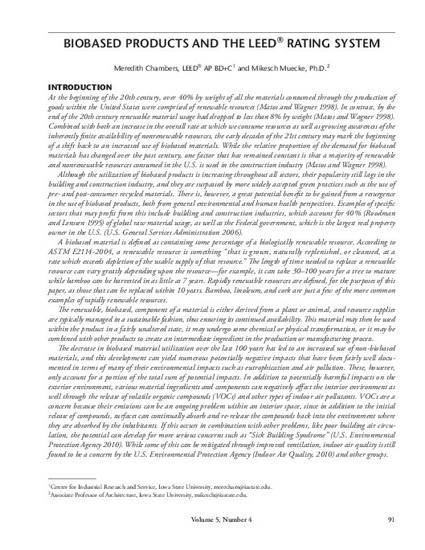
At the beginning of the 20th century, over 40% by weight of all the materials consumed through the production of goods within the United States were comprised of renewable resources (Matos and Wagner 1998). In contrast, by the end of the 20th century renewable material usage had dropped to less than 8% by weight (Matos and Wagner 1998). Combined with both an increase in the overall rate at which we consume resources as well as growing awareness of the inherently finite availability of nonrenewable resources, the early decades of the 21st century may mark the beginning of a shift back to an increased use of biobased materials. While the relative proportion of the demand for biobased materials has changed over the past century, one factor that has remained constant is that a majority of renewable and nonrenewable resources consumed in the U.S. is used in the construction industry (Matos and Wagner 1998).
Although the utilization of biobased products is increasing throughout all sectors, their popularity still lags in the building and construction industry, and they are surpassed by more widely accepted green practices such as the use of pre- and post-consumer recycled materials. There is, however, a great potential benefit to be gained from a resurgence in the use of biobased products, both from general environmental and human health perspectives. Examples of specific sectors that may profit from this include building and construction industries, which account for 40% (Roodman and Lenssen 1995) of global raw material usage, as well as the Federal government, which is the largest real property owner in the U.S. (U.S. General Services Administration 2006).
A biobased material is defined as containing some percentage of a biologically renewable resource. According to ASTM E2114-2004, a renewable resource is something “that is grown, naturally replenished, or cleansed, at a rate which exceeds depletion of the usable supply of that resource.” The length of time needed to replace a renewable resource can vary greatly depending upon the resource—for example, it can take 30–100 years for a tree to mature while bamboo can be harvested in as little as 7 years. Rapidly renewable resources are defined, for the purposes of this paper, as those that can be replaced within 10 years. Bamboo, linoleum, and cork are just a few of the more common examples of rapidly renewable resources.
The renewable, biobased, component of a material is either derived from a plant or animal, and resource supplies are typically managed in a sustainable fashion, thus ensuring its continued availability. This material may then be used within the product in a fairly unaltered state, it may undergo some chemical or physical transformation, or it may be combined with other products to create an intermediate ingredient in the production or manufacturing process.
The decrease in biobased material utilization over the last 100 years has led to an increased use of non-biobased materials, and this development can yield numerous potentially negative impacts that have been fairly well documented in terms of many of their environmental impacts such as eutrophication and air pollution. These, however, only account for a portion of the total sum of potential impacts. In addition to potentially harmful impacts on the exterior environment, various material ingredients and components can negatively affect the interior environment as well through the release of volatile organic compounds (VOCs) and other types of indoor air pollutants. VOCs are a concern because their emissions can be an ongoing problem within an interior space, since in addition to the initial release of compounds, surfaces can continually absorb and re-release the compounds back into the environment where they are absorbed by the inhabitants. If this occurs in combination with other problems, like poor building air circulation, the potential can develop for more serious concerns such as “Sick Building Syndrome” (U.S. Environmental Protection Agency 2010). While some of this can be mitigated through improved ventilation, indoor air quality is still found to be a concern by the U.S. Environmental Protection Agency (Indoor Air Quality, 2010) and other groups.
One of the most well known indoor air contaminants is formaldehyde, which is commonly found in the adhesives used in pressed wood products such as furniture, shelving, or particleboard; finishes and coatings on fabrics; paints and coatings; as well as some types of insulation.3 A 2008 study by Papadopoula, Nakos, and Tsiantzi examined the replacement of the formaldehyde-based resins with certain renewably based ones that yielded equivalent, and in some cases superior, performance characteristics in addition to providing a reduction in VOC levels. Another study that investigated school cleaning products found that, on average, the contaminate emission rate for green general cleaners was one fifth that of conventional cleaners (Environmental Working Group 2009). Other studies too, have shown correlations between the use of petroleum-based products and increased VOC levels.
A joint report by the Healthy Building Network and Health Care Without Harm (Silas, Hansen, and Lent, 2007) also promotes the use of renewable materials to lessen indoor air quality concerns, and it provides guidelines and information for the health care industry on the benefits of renewable and biobased materials as well as the potential issues associated with petrochemical-based fibers. Additionally, the Healthy Building Network offers biopolymer and bioplastic production and purchasing guidelines.
These environmental and health related concerns, as well as the potential market for biobased products, have become the focus of a variety of different areas of legislation and development. In addition to numerous Federal initiatives, an increased awareness of biobased materials and products is also being fostered within the building and construction fields by building rating systems such as Energy Star®, Green Globes, and Leadership in Energy and Environmental Design (LEED®).
Available at: http://works.bepress.com/mikesch-muecke/4/

This article is from Journal of Green Building 5 (2010): 91–107, doi:10.3992/jgb.5.4.91. Posted with permission.